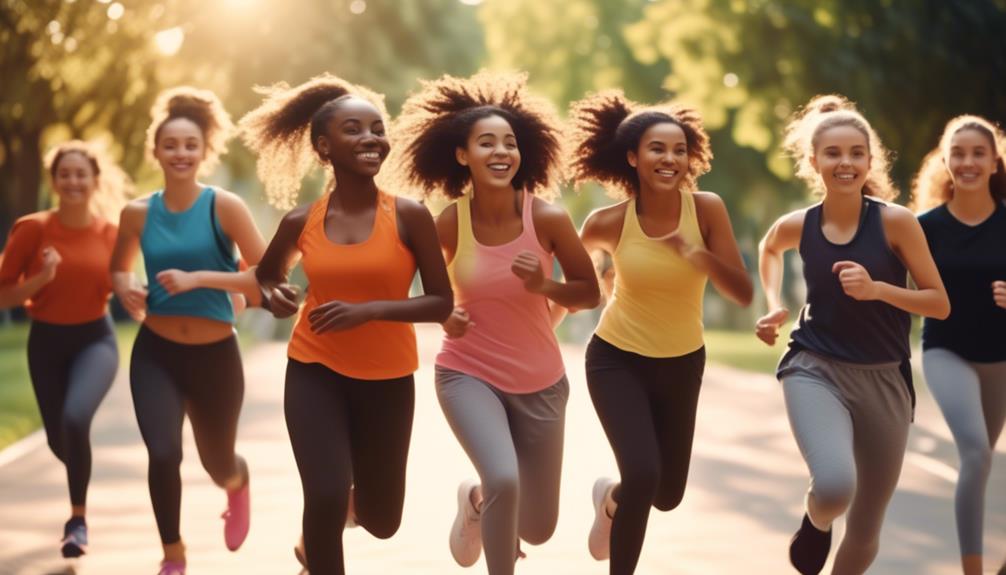How to Nurture Positive Attitudes Toward Physical Fitness in Adolescents

Fostering positive attitudes towards physical fitness in adolescents and creating an enjoyable environment that encourages participation are important for promoting a healthy lifestyle. Here are some strategies to achieve this:
- Make physical activity fun and enjoyable: Incorporate activities that are engaging and exciting for adolescents. This can include team sports, dance classes, or adventure-based activities. Providing a variety of options allows adolescents to find activities they genuinely enjoy and look forward to participating in.
- Focus on intrinsic motivation: Encourage adolescents to engage in physical activity for the joy of movement and the benefits it brings to their overall well-being. Emphasize the positive feelings and sense of accomplishment that comes with being physically active, rather than focusing solely on external rewards or appearance.
- Promote inclusivity and positive body image: Create an environment where all body types and fitness levels are embraced and celebrated. Encourage adolescents to appreciate their bodies for what they can do, rather than solely focusing on their appearance. Promote positive body image through activities that build strength, endurance, and confidence.
- Provide opportunities for social interaction: Adolescents often value social connections, so incorporating group activities and opportunities for teamwork can be highly motivating. Organize group workouts, team sports, or fitness challenges that allow adolescents to bond with their peers while engaging in physical activity.
- Offer choice and autonomy: Give adolescents the freedom to choose activities that align with their interests and preferences. Allowing them to have a say in the types of activities they participate in can increase their motivation and sense of ownership over their own fitness journey.
- Recognize and celebrate achievements: Acknowledge and celebrate the progress and achievements of adolescents in their fitness journey. Whether it's reaching a personal goal or demonstrating improved skills, recognizing their efforts and accomplishments can boost their self-esteem and motivation to continue participating in physical fitness.
By implementing these strategies, we can create a positive and enjoyable environment that encourages adolescents to develop lifelong habits of physical fitness and well-being.
Creating a Supportive Environment
To create a supportive environment for adolescents' physical fitness, it's essential to foster a positive and encouraging atmosphere that promotes enjoyment, knowledge, and the perceived usefulness of physical activity. Positive attitudes towards physical activity play a crucial role in shaping adolescents' attitude towards participating in physical activities. By creating an environment that celebrates progress, attainment, and participation in physical activity, we can nurture these positive attitudes.
In schools, it's important to provide creative and captivating physical education and sports provision. Engaging and dynamic classes can help students develop a positive attitude towards physical activity. By showcasing positive role models within the school community, such as teachers and staff who display enthusiasm and active participation in physical activity, we can inspire and motivate adolescents to adopt a similar mindset.
Involving parents and carers in school sport activities is another way to promote positive attitudes towards physical activity. Their participation and support can demonstrate the importance of being active and encourage adolescents to embrace physical fitness as a lifestyle. Additionally, considering parent and child fitness classes can create a shared experience that strengthens family bonds and promotes a positive attitude towards physical activity.
Providing Access to Physical Activity Opportunities
Schools play a pivotal role in providing diverse and inclusive opportunities for all students to engage in physical activity. By offering a range of physical activity opportunities, schools can positively influence attitudes towards Physical Education (PE) and increase participation in physical activity among school students. It's important for schools to ensure that all students, including those with special educational needs and disabilities (SEND) and those who are part of inactivity groups, have access to these opportunities.
To provide access to physical activity opportunities, schools can implement sports leadership programs, afterschool programs, and community club programs. These programs allow students to explore different activities and develop their skills in a supportive and inclusive environment. Additionally, schools can introduce physical intervention programs to improve motor skills and physical literacy in students.
Celebrating progress, attainment, and participation in physical activity is also essential. Schools can organize daily or weekly celebrations, recognize the PE pupil of the week, and provide other forms of recognition to foster a positive environment that encourages students to engage in physical activity.
Furthermore, schools should establish positive relationships with other schools to share good practices in promoting physical activity. By collaborating and learning from one another, schools can create a network of support and continuously improve the opportunities they provide to their students.
Educating About the Benefits of Exercise
Did you know that regular exercise offers a multitude of health benefits? Not only does it help you maintain a healthy weight and reduce the risk of chronic diseases, but it also boosts your self-esteem and enhances your overall well-being.
Exercise is a fantastic stress reliever too, allowing you to release tension and clear your mind.
Health Benefits of Exercise
When you engage in regular exercise, you unlock a world of health benefits that can improve your physical and mental well-being.
For adolescents like you who are looking to develop positive attitudes toward physical fitness, understanding the health benefits of exercise is crucial.
First and foremost, regular physical activity can lead to better overall health, helping you stay fit and reducing the risk of chronic diseases as you grow older.
But that's not all. Exercise also contributes to building strong bones and muscles, which is especially important during your adolescent years.
Additionally, physical activity promotes better sleep quality and increases your energy levels, allowing you to tackle your daily tasks with enthusiasm.
Moreover, exercise has been shown to enhance cognitive function, leading to improved academic performance and increased focus.
Finally, regular exercise can improve your mood, reduce stress, and boost your self-esteem.
Boosting Self-Esteem Through Fitness
Boost your self-esteem and confidence through the power of fitness and exercise. Physical fitness has been shown to have a positive impact on self-esteem, especially in adolescents. By engaging in regular physical activity, you can experience a sense of accomplishment and pride in your abilities. Exercise helps to improve your overall mood and mental well-being, reducing feelings of stress and anxiety. It also promotes better body image and self-acceptance, as you focus on what your body can do rather than how it looks. To help you understand the benefits of exercise, take a look at the table below:
| Positive Attitudes | Physical Fitness | Adolescents |
|---|---|---|
| Increased self-esteem | Improved physical health | Boosted confidence |
| Enhanced body image | Reduced risk of chronic diseases | Better mental well-being |
| Sense of accomplishment | Increased energy levels | Improved focus and concentration |
| Increased social interaction | Better sleep quality | Reduced stress and anxiety |
Exercise as Stress Relief
Looking for a way to manage daily pressures and emotions? Discover how exercise can serve as a stress relief mechanism, helping you find balance and boost your well-being.
Physical fitness isn't just about improving your body; it also has a profound impact on your mental health. Engaging in regular exercise can reduce anxiety, improve mood, and increase overall happiness. When you exercise, your body releases endorphins, which are natural mood boosters. Additionally, exercise helps to reduce cortisol, the stress hormone, in your body.
By incorporating physical activity into your daily routine, you can effectively manage stress levels and find relief from the pressures of adolescence. Whether it's going for a run, joining a sports team, or practicing yoga, find an activity that brings you joy and acts as a stress-relieving outlet.
Take the time to prioritize your well-being and make exercise a part of your stress management toolkit.
Fostering a Positive Mindset
To foster a positive mindset towards physical fitness in adolescents, it's crucial to promote enjoyment, knowledge, and perceived usefulness of physical activity.
Adolescents are more likely to engage in physical activity if they find it enjoyable. Therefore, it's important to provide creative and captivating physical education and sport provision in schools. This can involve incorporating fun and interactive games, team sports, and various exercise routines. By making physical activity enjoyable, adolescents are more likely to develop positive attitudes towards it.
In addition to enjoyment, knowledge about the benefits of physical activity is essential in fostering a positive mindset. Educating adolescents about how physical activity can improve their overall health and well-being can motivate them to engage in regular exercise. By highlighting the positive effects of physical activity, such as increased energy levels, improved mood, and better sleep, adolescents will be more inclined to prioritize physical fitness in their lives.
Furthermore, perceived usefulness of physical activity plays a significant role in shaping positive attitudes towards it. Adolescents need to understand that physical activity isn't only beneficial for their physical health but also for their mental well-being. By promoting physical activity as a stress reliever and a way to improve focus and concentration, adolescents will perceive it as a valuable tool in their lives.
Encouraging Variety in Physical Activities
Encouraging adolescents to explore a wide range of physical activities can ignite their curiosity, foster a sense of adventure, and open doors to new opportunities for personal growth. By promoting variety in physical activities, you can help adolescents develop positive attitudes towards fitness and discover their true passions.
Here are five ways to encourage variety in physical activities for adolescents:
- Support and promote the exploration of different sports and activities: Encourage adolescents to try out different sports, such as basketball, soccer, swimming, or martial arts. This allows them to discover their interests and find joy in a particular activity.
- Emphasize the enjoyment and benefits of trying new physical activities: Highlight the excitement of trying something new and the potential health benefits it can bring. Emphasize that variety keeps things interesting and prevents boredom.
- Provide access to diverse physical activities: Ensure that adolescents have access to a range of physical activities, including team sports, individual pursuits, and non-traditional activities like yoga or dance. This allows them to explore and find activities that resonate with their interests and abilities.
- Highlight the value of adapting and learning new skills: Encourage adolescents to adapt and learn new skills in different physical activities. This helps build confidence, resilience, and a growth mindset.
- Celebrate achievements and progress: Recognize and celebrate the achievements and progress made by adolescents in different physical activities. This fosters a positive attitude towards variety and encourages them to continue exploring new activities.
Avoiding Negative Language and Attitudes
When it comes to nurturing positive attitudes toward physical fitness in adolescents, it's crucial to be mindful of the language and attitudes we use.
Negative comments or criticisms can have a detrimental impact on their motivation and self-esteem.
Instead, focus on using positive language and encouraging a positive mindset, emphasizing the joy of movement and the many benefits of physical fitness.
Language Impact on Attitudes
Using positive language is crucial in fostering a supportive and motivating environment for physical fitness among adolescents. When it comes to language impact on attitudes, it's important to avoid negative language and attitudes to encourage adolescents to embrace a healthy lifestyle. Here are some tips for using positive language:
- Emphasize the benefits of physical activity, such as improved physical and mental health.
- Frame exercise in a constructive and motivating way, focusing on the joy and fulfillment it brings.
- Foster positive relationships by promoting teamwork and cooperation during physical activities.
- Encourage skills development by highlighting the progress and achievements that come with regular exercise.
- Create a supportive and encouraging environment where adolescents feel motivated and empowered to make positive changes in their attitudes and behaviors.
Encouraging Positive Mindset
To create a supportive and motivating environment for physical fitness among adolescents, it is crucial to foster positive language and attitudes, avoiding any negativity that may hinder their progress. Encouraging your child to adopt a positive mindset plays an important role in shaping their thoughts and behaviors towards active living. By avoiding negative language and attitudes, you can help them develop a healthy relationship with physical fitness.
When it comes to fostering a positive mindset, celebrating progress, participation, and effort is key. Focus on praising their achievements, no matter how small, to instill a sense of pride and motivation. Additionally, modeling an active lifestyle and involving parents or carers in supporting positive attitudes towards physical activity can further reinforce the importance of a positive mindset.
Here is a table that provides some practical tips for encouraging a positive mindset:
| Encouraging Positive Mindset |
|---|
| Avoid negative comments |
| Focus on positive encouragement |
| Celebrate progress, participation, and effort |
| Model an active lifestyle |
| Involve parents/carers in supporting positive attitudes |
Monitoring and Supporting Behavior Changes
To effectively monitor and support behavior changes in adolescents, it's essential to establish a nurturing environment that encourages and celebrates their progress toward physical fitness goals. By implementing the following strategies, you can help adolescents develop positive attitudes towards physical fitness and motivate them to engage in appropriate physical activities:
- Encourage self-monitoring: Encourage adolescents to keep track of their physical activity by maintaining a daily log or using a fitness app. This allows them to take ownership of their progress and stay accountable.
- Provide positive reinforcement: Acknowledge and celebrate their achievements and progress. Offer words of encouragement and rewards to motivate them to continue making behavior changes.
- Offer guidance and resources: Provide guidance on behavior changes by offering resources such as fitness trackers or workout plans. This helps adolescents navigate their fitness journey and develop skills necessary for physical activities.
- Create a supportive environment: Involve family and friends in physical activities to create a supportive network. Setting achievable goals together and engaging in physical activities as a group can enhance motivation and make the experience more enjoyable.
- Monitor and adjust: Continuously monitor and adjust behavior changes based on individual needs and preferences. This ensures sustained motivation and participation in physical fitness.
Frequently Asked Questions
How Can You Achieve Positive Attitude Towards Physical Activity?
To achieve a positive attitude towards physical activity, you need to focus on the benefits and motivation it brings. Engage in fun activities, find role models to inspire you, and set goals while tracking your progress.
How Would You Encourage the Youth to Engage in Physical Exercise?
You can encourage the youth to engage in physical exercise by providing fun activities, social support, positive role models, and incentives. Make it enjoyable, create a supportive environment, and reward their efforts to motivate them.
How Can You Help Children Develop Positive Attitudes Toward All People?
To help children develop positive attitudes toward all people, focus on developing empathy, promoting inclusivity, fostering kindness, and encouraging acceptance. Teach them to value diversity, practice active listening, and treat others with respect and understanding.
How Do You Model and Teach Healthy Attitudes Towards Physical Activity?
You model healthy attitudes towards physical activity by actively participating and showcasing a positive mindset. Teach techniques, promote motivation, and encourage participation. Engage and inspire others to prioritize their well-being through exercise.










